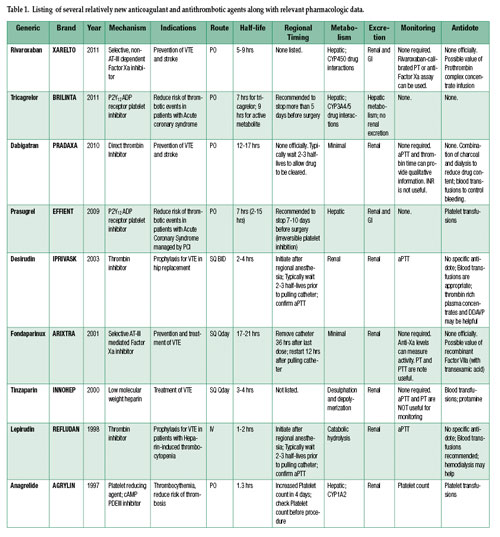In the last decade, several new anticoagulation medications have become available on the market. Table 1 summarizes several of these new drugs as well as relevant pharmacologic data. Primarily these agents are being used for stroke prevention in patients with atrial fibrillation or for the prevention of venous thromboembolic events (VTE) in the perioperative period. The appeal of many of these agents to our colleagues and patients is their ease of administration, with once or twice daily dosing, and the lack of need for therapeutic monitoring. The newest agents are orally administered as well.
However, for anesthesiologists, these drugs are often under-recognized as potential hazards during urgent operations and procedures such as regional anesthesia. In particular, patients are at high risk of developing epidural hematoma and neurologic complications during neuraxial anesthesia. Becoming familiar with the names, mechanism of action, and predicted half-life of these drugs is critical to safe anesthesia practice.

This information is intended only to increase awareness about the new anticoagulation medications appearing on the market and not to serve as peer-reviewed recommendations for patient care. Refer to the American Society of Regional Anesthesia guidelines on anticoagulation for more comprehensive consensus statements regarding patient management.
Dr. Gupta is Assistant Professor and Associate Director of Adult Acute Pain Service Vanderbilt University, Nashville, TN
References
- Horlocker TT, Wedel DJ, Rowlingson JC, et al. Regional anesthesia in the patient receiving antithrombotic or thrombolytic therapy: American Society of Regional Anesthesia and Pain Medicine evidence-based guidelines (Third Edition). Reg Anesth Pain Med 2010;35:64-101.
- Singelyn FJ, Verheyen CC, Piovella F, et al. The safety and efficacy of extended thromboprophylaxis with fondaparinux after major orthopedic surgery of the lower limb with or without a neuraxial or deep peripheral nerve catheter: the EXPERT study. Anesth Analg 2007;105:1540-7.
- Eerenberg ES, Kamphuisen PW, Sijpkens MK, et al. Reversal of rivaroxaban and dabigatran by prothrombin complex concentrate: a randomized, placebo-controlled, crossover study in healthy subjects. Circulation 2011;124:1573-9.
- XARELTO® full prescribing information.
- BRILINTA® full prescribing information.
- PRADAXA® full prescribing information.
- EFFIENT® full prescribing information.
- IPRIVASK® full prescribing information.
- ARIXTRA® full prescribing information.
- INNOHEP® full prescribing information.
- REFLUDAN® full prescribing information.
- AGRYLIN® full prescribing information.


 Issue PDF
Issue PDF